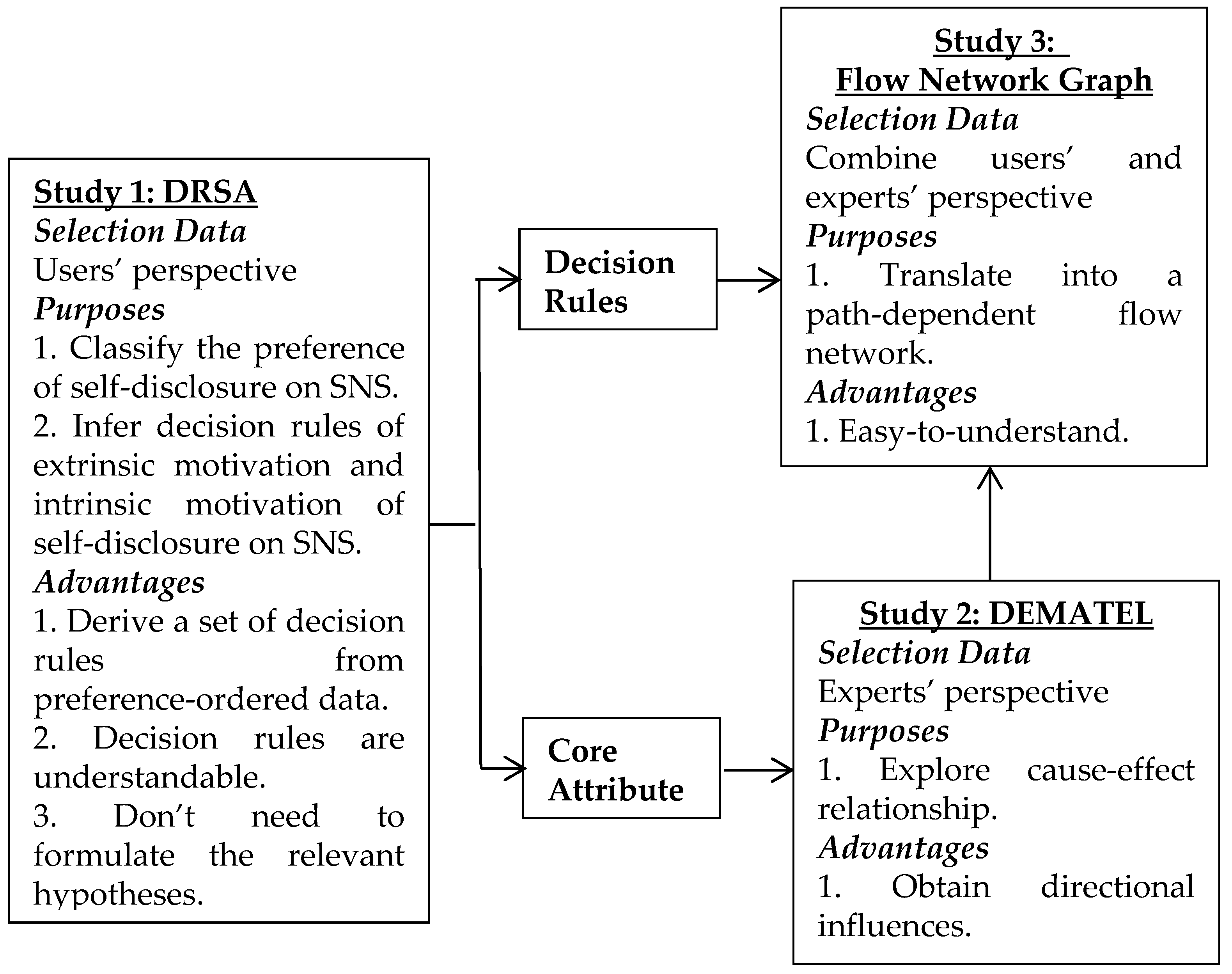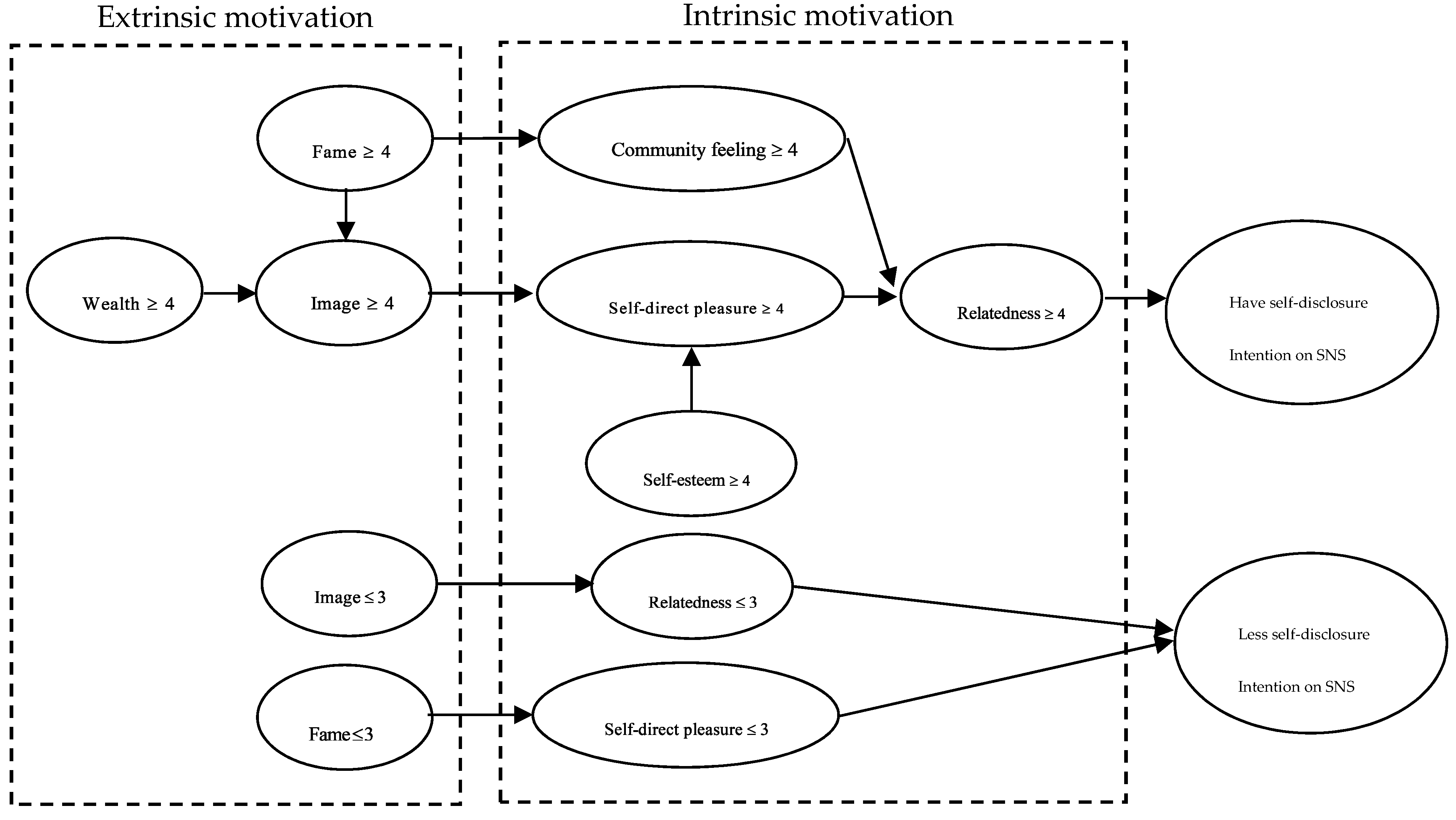1. Introduction
Social networking sites (SNS) are popular multimedia communication channels that collect user profiles; registered members can use their profiles to share information or express opinions and attitudes [
1]. Nowadays, websites such as Facebook are at the forefront of online social networking, attracting more than two billion monthly active users. Because of the increasing importance of SNS, several organizations have begun to manage their SNS to build relationships with users, promote services, improve communication, and stimulate users to share real information. Based on the shared details, personalized advertisements are presented to the users [
2]. However, in 2018, the Facebook–Cambridge Analytica data scandal (which involved nearly a million users’ personally identifiable information) reduced users’ willingness to share personal information. Because personal privacy is a crucial factor of self-disclosure behaviors on SNS, SNS managers should carefully formulate strategies encouraging users to provide accurate information about themselves on SNS [
3,
4].
Notably, SNS required to launch new services continues to increase involvement at a substantial pace for competitiveness. This is primarily because users demand more functions, entertainment, and better quality new service. In addition, the dramatic growth in popularity on SNS has promoted the advent of many new SNS. To sustain development becomes an important issue for SNS marketers. Prior studies have discussed SNS business sustainability, such as sustainable development of online communities [
5], attitudes expressed in online comments of the hotel industry [
6,
7] and big social network data of sustainable development [
8]. The results show that managers who succeed in understanding users’ characteristics can improve business sustainability.
Self-disclosure intention is defined as the degree of willingness to distribute an individual’s private information through a specific medium [
9]. In social media, motivation plays an essential role in influencing consumer actions [
10]. Motivation can be divided into extrinsic and intrinsic motivation [
11]. Extrinsic motivation is driven by several attributes of wealth, fame, and image, which emphasize the individual’s desire for external rewards; intrinsic motivation is driven by several attributes of self-esteem, personal growth, community feeling, self-directed pleasure, and relatedness, which emphasize the individual’s desire for inherent qualities [
12,
13]. Numerous studies of self-disclosure have measured motivation on SNS [
14,
15,
16]. The size and growth of the Internet has attracted increasing research for addressing prestige related to self-disclosure on SNS. However, compared with other research sectors, few studies are available regarding the application of a systemic decision model in SNS.
The main concerns in application of a systemic decision model are as follows: (1) What motivation influences users’ self-disclosure intention on SNS? (2) What is the relationship between extrinsic and intrinsic motivation attributes? (3) What are the key extrinsic and intrinsic motivation attributes that influence users’ self-disclosure intention on SNS? To gain new insights regarding self-disclosure, this research presents a multiple criteria decision-making (MCDM) model by using soft computing theories to examine the key attributes of extrinsic and intrinsic motivation to understand how the predictors influence users’ self-disclosure on SNS. Some published studies have concluded that application of MCDM for business sustainability can have implications for marketers [
17]. However, such studies have adopted either secondary data or domain experts’ experience, or both [
18,
19], rather than user psychology data.
Thus, to extend the application area, we collected user psychology data through a questionnaire and then applied a dominance-based rough set approach (DRSA) to infer decision rules from the preference orderings of attributes [
20]. These decision rules have the form:
if (premise)
then (decision) [
21]. Hence, data mining the questionnaires to examine the attributes may explain users’ self-disclosure preferences.
Through collection of user psychology data using a similar survey of a questionnaire, SNS marketers can better understand the attributes influencing self-disclosure. However, marketers would not have a clear conception of the relationship between attributes for strategic decision making. Therefore, the next step involves applying decision-making trial and evaluation laboratory (DEMATEL) to evaluate the relationships between the attributes from the domain experts’ perspective to enhance our understanding of complex systems.
Although the decision rules derived through DRSA and the relationships between attributes established through DEMATEL can be directly translated into a path dependency graph [
14], most studies have not yet adequately translated the users’ and experts’ perspectives into a diagram. A flow network graph is easy for SNS marketers to understand and depicts the main attributes and relationships between the attributes simultaneously. Hence, this study applied a flow network graph to present the results.
Building an effective model to improve users’ self-disclosure on SNS has become a vital aspect of SNS survival in today’s competitive environment. Therefore, unlike prior studies focusing on statistical hypotheses to understand the relationship between motivation and self-disclosure, this study constructed a cause-and-effect model. This study explains the extrinsic (wealth, fame, and image) and intrinsic motivations (self-esteem, personal growth, community feeling, self-directed pleasure, and relatedness) of self-disclosure on SNS by combining the DRSA, DEMATEL, and a flow network graph.
The remainder of this paper is organized as follows.
Section 2 introduces some soft computing theories.
Section 3 illustrates an empirical example of SNS to demonstrate the proposed methods. Finally,
Section 4 presents conclusions and remarks.
3. Relevant Soft Computing Theories
To understand the influence of extrinsic and intrinsic motivation on the users’ self-disclosure intention on SNS, this study applied DRSA to infer decision rules from preference-ordered data, then adopted DEMATEL to examine the relationships between motivation attributes, and finally used a flow network graph to depict the results as a diagram. This section reviews some relevant soft computing theories.
3.1. The Dominance-Based Rough Set Approach
Step 1: Construct the information system to the survey
DRSA is derived from classical rough set theory; DRSA infers decision rules from the preference orderings of attributes. The preference orderings of attributes use an ordered information system
, where
is a finite set representing the universe of discourse (i.e., the participants in the survey);
is a finite set of ordered attributes, which is further divided into
(condition attributes, i.e., extrinsic and intrinsic motivation in this study) and
(decision attributes, i.e., self-disclosure intention in this study);
is the value domain of attribute
, where
is the total information function, in which
for every
and
[
16]. The first empirical step is to construct the information system by completing a questionnaire.
Step 2: Approximation of the dominance relation
In approximation, first,
indicates an outranking relation on set
regarding to some criterion for each
(i.e.,
denotes that
is at least not worse than
on attribute
). Here,
is defined as a set of decision classes of
. Assuming that for all
,
indicates that
. Then, upward and downward unions of classes are defined as follows:
In addition, for the preference-ordered condition attributes, the knowledge to be approximated uses a dominance relation instead of indiscernibility. In this case, and represent sets of objects dominating or being dominated by respectively.
The P-lower of can be defined as for , and similarly the P-upper of can be defined as for with the P-boundaries of defined as and the P-boundaries of defined as .
With each set of
, the approximation of
and
can be estimated with the following expression:
The quality of approximation of classification (or the quality of classification) by the set of attributes is called . The quality of classification indicates the ratio of all of the P-correctly classified objects (i.e., the ratio of all of the non-ambiguous participants to all of the participants in the system).
Step 3: Extraction of the decision rules
The end result of the DRSA is to infer significant information in the considered information system. The decision table is a deterministic or exact decision rule expressed logically in the form: if (premise) then (decision). There are two types of decision rules:
- (1)
The “at least decision rule” is supported only by objects from P-lower approximations of the upward unions of classes , using the following expression:
If and and … , then .
- (2)
The “at most” decision rule” is supported only by objects from P-lower approximations of the upward unions of classes , using the following expression:
If and and … , then .
In general, the decision rule reflects a relationship between a set of conditions attributes and a decision attribute. Hence, in this study, the decision rules were generated based on upper and lower approximations extracted from the information system by using dominance relations.
3.2. DEMATEL
DEMATEL can analyze complicated cause-and-effect societal problems between dimensions and attributes. The results of these analyses can be used verifying independence and finding influence relationships [
44]. To deal with the ambiguities of SNS user psychology, this study evaluated user preferences regarding the extrinsic and intrinsic motivation attributes by using DEMATEL. This methodology can be summarized as follows:
Step 4: Calculate the direct-influence matrix
First, each expert was asked to indicate the direct effects they believed attribute
exerted on attribute
, as indicated by
, with a scale from 0 (no influence) to 4 (very high influence), and then an average matrix
was produced from Equation (3). In matrix
, each element was the mean of the same elements in the experts’ various direct matrices.
Step 5: Calculate the normalize matrix
The initial direct influence matrix
was obtained by normalizing the average matrix
Specifically, the matrix
can be calculated through Equations (4) and (5), in which all the principal diagonal attributes are equal to zero, and constant
could be normalized for matrix
.
Step 6: Total influence relation matrix
After the normalized direct relation matrix has been calculated,
denotes the identity matrix in the total influence matrix
. As a result of continuous decrease in the indirect effects of problems along the powers of
, the total influence relation matrix
can be calculated through Equation (6):
Step 7: The cause-and-effect relationships of attributes
According to Equation (6), we derive
and
from row and column sums within the total relation matrix
as:
Furthermore, when and , the sum () indicates the index of the degree of influences given and received by the attribute . Similarly, () denotes the net effect that the attribute contributes to the system. If () is positive, then the attribute primarily influences the strength of some other attribute; on the contrary, if () is negative, then the attribute primarily is a net receiver. Therefore, in this study, the cause-and-effect influence between the extrinsic and intrinsic motivation attributes is analyzed using DEMATEL to produce a flow networking graph.
3.3. The Flow Network Graph
Step 8: The cause-and-effect of decision rules based on the flow network graph
Flow network graphs can describe the nature of decision processes. In addition, a flow network graph is an excellent tool to describe the decision rules and the relationships between the attributes [
42,
43]. With a flow network graph and decision rules of user self-disclosure intention characteristics, this research derived a cause-and-effect path-dependent figure. The resultant figure depends on the rules and relationships between attributes of self-disclosure intention potential.







